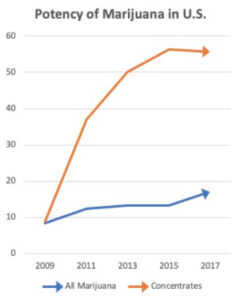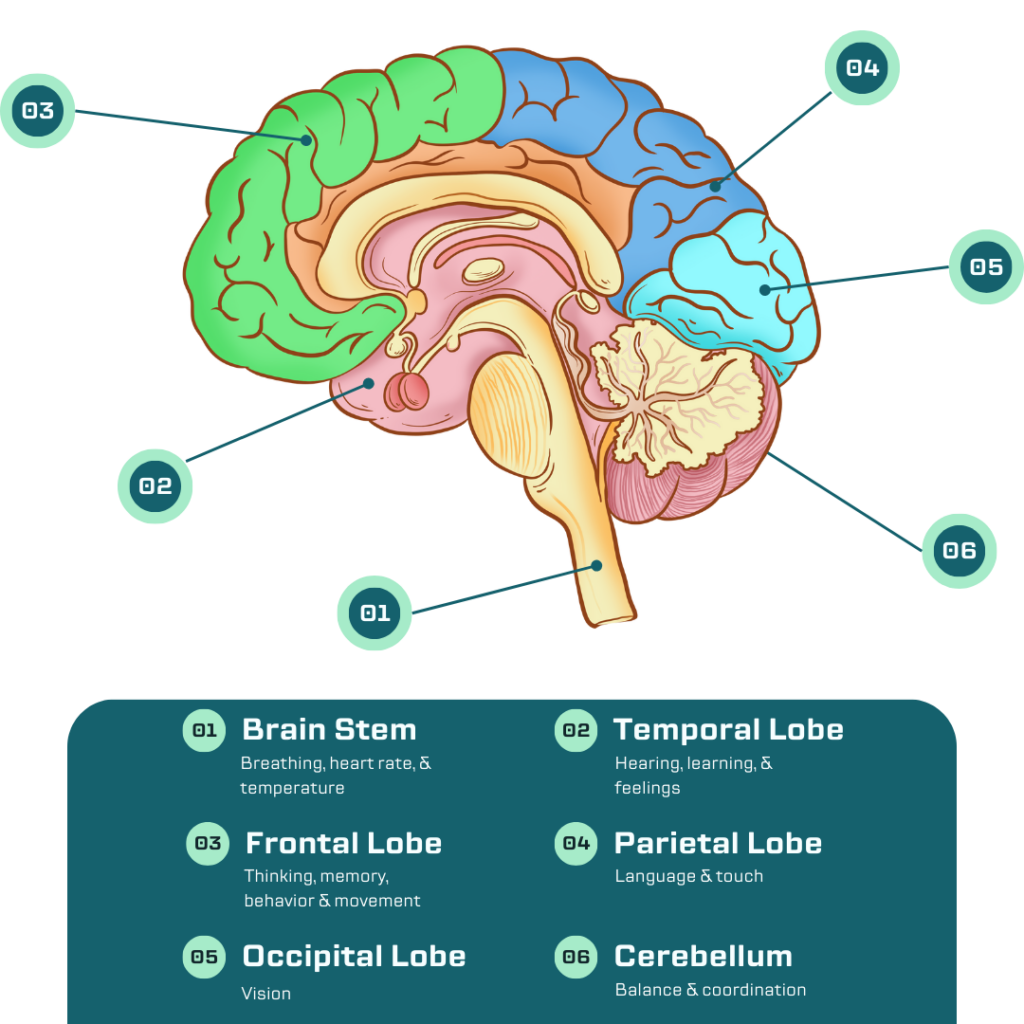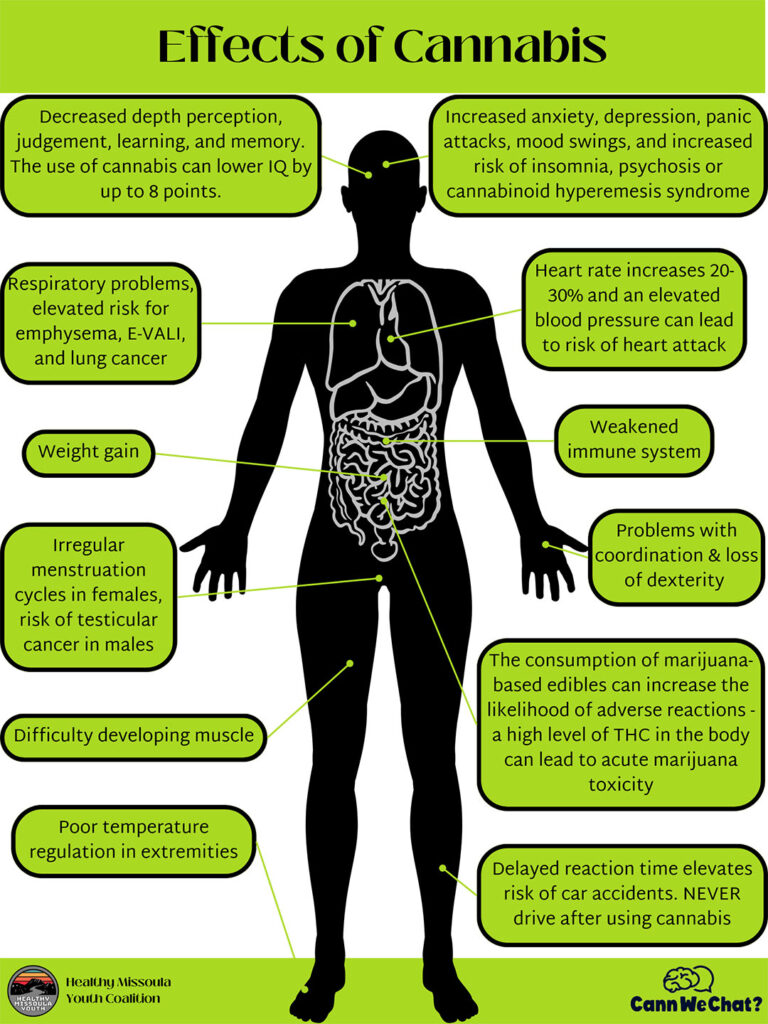Why Should You be Concerned about Marijuana Use?
Today’s Cannabis is Different
 For those of you who have not been on the scene in a while (or ever) – it’s important to understand today’s marijuana is different from what was used in the past: It is not your hippie weed, 90s weed, or even the same as it was in 2000.
For those of you who have not been on the scene in a while (or ever) – it’s important to understand today’s marijuana is different from what was used in the past: It is not your hippie weed, 90s weed, or even the same as it was in 2000.
In 2000, the average potency of THC (the part of cannabis that produces the “high”) was 5%, in 2017 more than 17%. Nowadays the THC limit for flower in Montana is 35%, with Concentrates (like edibles, dab-pens, etc) up to 99% THC.
So what is THC? Does the THC percentage matter?
Tetrahydrocannabinol or “THC” is the psychoactive (or “mind-altering”) part of cannabis – the part that is responsible for the “high” or euphoric feeling associated with cannabis use. The THC percentage generally describes the overall amount of THC in that product when measured by volume, aka the potency of the product. High THC is considered anything at or above 15%.
There is a dose-response relationship between THC and health risks: higher potency and/or more frequent use of cannabis is linked to an increased risk of harm. The risks of physical dependence and addiction increase with exposure to high concentrations of THC, and higher doses of THC are more likely to produce anxiety, agitation, paranoia, and psychosis.
Terminology & Types of Marijuana
There is a lot of different lingo that is used when talking about cannabis, so what does it all mean?
The important thing to note here is that regardless of the type of cannabis used, it can still cause harm. Different methods of use can change how long the effects of cannabis impact your body and mind. For example, the effects of smoking/vaping can last for longer than 6 hours after use, and the effects of edibles can remain for more than 8 hours after ingestion (Source linked here). This is why you should NEVER drive after using cannabis.
Dried cannabis flower, also known more commonly as “weed,” is a form of cannabis that is generally smoked and then inhaled either through a joint, bong, or hookah.
Average THC Potency: 10-30%
Cannabis concentrates are highly potent extracts of the cannabis plant. They often contain a higher potency of THC and can be chemically processed in various ways, thus producing different variations like Shatter or Budder.
These are all considered Extracts from the cannabis plant, resembling a semi-solid wax. Some may resemble softened butter (called budder), cake batter (badder), or resin (rosin) depending on thickness and texture. There is also honeycomb, sugar, and crumble, named for their structure or flakiness. These are often used in dabs. (Dabbing just means a small amount of concentrate which the user burns and inhales- often vaping.)
Live resin is another form of cannabis concentrate that comes from the cannabis leaves once they are flash-frozen and removed with a solvent like butane (a gas commonly found in lighter fluid) or CO2. The concentrate that is removed looks like wax and is commonly smoked in a joint or a bowl.
Average THC Potency: 65-95%
A dab-pen or THC vape is a type of electronic cigarette that uses vaping oils and THC concentrates to dispense cannabis. It heats the “e-juice” and aerosolizes it for an individual to inhale.
Average THC Potency: 65-90%
A distillate or oil refers to ultra-refined extracts from the cannabis plant found in vape cartridges, edibles, and topical products. Distillates contain a single desired strain (example:indica vs. sativa) in a potent amber colored oil.
Average THC Potency: 85-90%
An edible is a food or drink, often a sweet or a small snack like a cookie, that is infused with THC. Legally, there should be no more than 10 mg of THC per serving and no more than 100 mg per package. This can be especially dangerous for youth because often a small product (such as a single gummy bear) can contain more than one serving of THC.
Average THC Potency: 5-10mg per serving*
*Cannabis edibles are measured in milligrams of THC per serving as opposed to percentages.
A flavorful, solvent-based infusion that is often consumed with edibles, placed under the tongue or sprinkled on food. An infusion made by soaking the cannabis leaf in a weak solvent like alcohol or glycerin. The THC content in this is typically low – often less than 1%.
Cannabidiol or “CBD” is a type of cannabinoid found in the cannabis plant. It is similar to tetrahydrocannabinol or “THC”, but does not produce the “high” or euphoria associated with use. CBD is often the part of cannabis that claims to have medicinal qualities that help with seizures or “relaxing” attributes.
Brain Health & Behavioral Health
How does Cannabis work in the brain?
What does this mean for your child?
The many different effects of cannabis on the developing brain can change the way your brain produces hormones (like dopamine & serotonin)
- Lowers IQ, memory
- ability to do well in school, attention span
- inhibits emotional development and ability to regulate
- Could potentially trigger serious mental or behavioral health issues
What areas of the brain are impacted by cannabis use?
Frontal Lobe: This part of the brain is typically responsible for critical thinking skills, personality, and decision-making. However, when influenced by cannabis, this part of the brain isn’t able to process information fully – which results in more impulsive behaviors, impaired memory, and a harder time problem-solving.
Temporal Lobe: The temporal lobe is in charge of things like hearing, learning, and feelings. When this part of the brain is affected by cannabis it can result in mood swings, more extreme emotions like increased anxiety or depression (a result of the impact on the amygdala), and decreased memory recall skills.
Brain Stem: Because the brain stem is in charge of regulating heart rate, cannabis can increase your heart rate abnormally and, with repeated use, cause heart disease. Cannabis can increase your heart rate up to 20-30%, and those effects can last up to 3-4 hours after the substance leaves your system. Your heart has to work harder to get good blood circulation, and eventually this can lead to things like heart attack.
Cerebellum: The Cerebellum is in charge of balance and coordination. An easy way of explaining how substance use can affect this part of the brain is to look at how law enforcement conducts DUI tests (and YES, in Montana you can get a DUI for driving under the influence of cannabis). Some tests include walking in a straight line and standing on one foot without wobbling, both of which measure balance and coordination. Cannabis use can decrease a person’s ability to do these skills.
Occipital Lobe: The Occipital lobe is in charge of how your brain processes vision. Because your brain is so overwhelmed with information while under the influence of cannabis, it tries to prioritize what is immediately in front of you rather than your full surroundings – as a result your peripheral vision is diminished (aka tunnel vision) and depth-perception may be altered. This is also why during a DUI stop the officers may do an eye test to see how well you can follow their finger when it moves around (they are looking for smooth movement vs “fidgety/shaky” eyes).
Parietal Lobe: Under the influence of cannabis the body’s pain receptors aren’t as effective, leading to a lesser pain response, and language processing is more challenging. For example: slurred words, incomplete sentences, misinterpreting the meaning of words or using the wrong word by accident.
“Approximately 1 in every 100 people who uses highly potent marijuana will manifest psychotic symptoms”
– American Addiction Center
Physical Health
In addition to the lung damage (such as respiratory problems, asthma attacks, infections, and emphysema) cannabis can cause from inhaling an aerosol, there are other concerns as well:
- poor depth perception and coordination
- slower reaction times
- weight gain
- difficulty developing new muscle
- weakened immune system
- chronic fatigue
“The consumption of marijuana-based edibles can increase the likelihood of adverse reactions - a high level of THC in the body can lead to acute marijuana toxicity.”
– American Addiction Center


